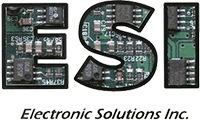Application Note AN-001  download a PDF version
download a PDF version
Electronic Solutions, Inc.
Rev. 12 October 2015
This document examines the differences between ESI’s standard and custom interlocks. It is intended to assist you in selecting the proper interlock for your application.
The end customer often has a bewildering combination of doors that have differing requirements for their facility. The four door types normally encountered are:
- Automatic door that is locked at all times when idle, with no possibility of manual operation
- Automatic door that is unlocked when idle and therefore may be opened manually, either deliberately or accidentally
- Manual door that utilizes a card reader or other actuating device and is locked at all times when idle
- Manual door that is unlocked when idle
Additionally, customers often request:
- Non-exclusive doors (Doors 1 and 2 are permitted to open together, but must be interlocked with Door 3)
- Red and/or green traffic lights
- So-called “soft” interlocks that utilize lights only and are on the “honor system”
- Supervisory contacts
- Custom timing requirements for specific doors
All of these requirements can be met with either a standard or a custom product from Electronic Solutions. The information below contrasts the two types of product.
Standard Interlock Features
The standard interlock package utilizes our ES520 module with stock Version 1.10 software. It supports up to four interlocked doors and is your least expensive option. However, it does have some very specific requirements that may render it unsuitable for your application. The standard software requires that:
- all doors be automatic (manual doors, and manual operation of automatic doors, are not permitted).
- all doors be locked when idle, either with electric strikes or magnetic locks.
- all doors be exclusive (only one door is permitted to be open at a time)
The standard software will not operate properly if all three of the above conditions are not met.
Custom Interlock Features
A custom interlock is considerably more expensive, but has the advantage of being far more versatile. With custom software, each door may be automatic or manual and either locked or unlocked when idle. Manual doors which are locked when idle and have an unlock signal (e.g. card reader) are also supported. Multiple non-exclusive combinations may be configured (for example, Doors 1 and 4 are permitted to open concurrently, but are interlocked with Doors 2 and 3). Such software can also optionally support red/green traffic lights or special timing requirements.
Custom interlocks are supplied with any of several hardware packages, depending on their complexity. The ES520 with ES525 expansion can support up to three doors. The ES550 will support up to four doors, and the ES550 with either one or two ES555 expansion modules as needed will support up to 12-16 doors.
To order a custom interlock, complete our Custom Interlock Specification Form and email or fax it to us. This form will be used both to quote your job and to generate your custom software package, so completeness and accuracy are imperative!
Other Features
All of our standard and custom interlocks feature “memory” operation. Requests for doors that are currently unavailable are stored and are serviced at the first available opportunity, and in the order received. Duplicate requests for doors that are already in memory are ignored. Although the vast majority of customers prefer the “memory” feature, if needed, interlocks are also available that do not store requests. Consult us for details.
Once a door is opened, it may be freely recycled via its actuator, safety beams, etc. without disrupting interlock operations.
An adjustable delay determines how long automatic doors are held open. Additionally, a second delay is provided for doors to finish closing once their position switch triggers. We call this the “close follow” delay, and its primary purpose is to insure that a door finishes closing before another door is opened, in case the position switch trips a little early.
Custom interlocks supporting manual doors which are locked when idle will also have a third delay which sets how long such doors are unlocked to allow access.
Other Requirements

threatening conditions must not be routed through the interlock system.
Electronic Solutions, Incorporated will not honor any requests for such a
configuration and assumes no liability if it is utilized. The emergency switches
must directly control their associated locks via suitable hard contact relays.
All doors must include a position switch which indicates when the door is open. In the standard interlock as well as most custom software packages, these switches may be either closed or open to indicate that the door is open, but all switches in a given system must utilize the same polarity.
To handle automatic doors that are locked when idle, we supply a single “unlock and open” contact rated 1A at 28VDC. The door control is expected to handle its own lock and provide unlock-to-actuate sequencing to prevent binding the door. If such functionality is not built into the door control, our ES530 module can provide the needed sequencing at minimal extra cost.
To handle automatic doors that are unlocked when idle, we supply one “lock door” contact and one “actuate door” contact. Both contacts are rated 1A minimum at 28VDC. The “lock door” contact is Form C and therefore may be used with either magnetic locks or electric strikes.
Manual doors are furnished a single Form C contact which may be used to either lock or unlock the door when needed. Magnetic locks and electric strikes are both supported. The use of hydraulic closers is strongly encouraged for all manual doors, as facility operations can be disrupted if a door is left open by a pedestrian.
download a PDF version
